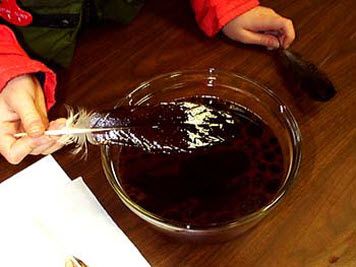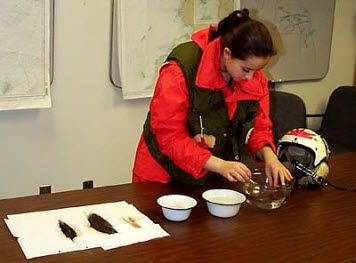Find the Best Way to Clean Oil off Bird Feathers
In this experiment for elementary school students, you'll look at the way oil affects bird feathers, and try different cleanup methods to find out which works best.
Materials
- Clean, dry feathers (some places where you can legally obtain feathers include pet stores, poultry farms, or craft stores)*
- Four bowls
- Vegetable oil
- Dish-washing detergent
- Hot, cold, and room-temperature water (the hot water should be about the same temperature you'd use to wash dishes and not too hot to put your hands in)
- 1 tablespoon cocoa powder (optional)
Instructions
1. Take a look at the feathers you've collected, then try to answer the following questions:
- What kinds of water birds can you think of? [possible answers]
- What kinds of things do water birds do? [possible answers]
- What do feathers do for water birds? [possible answers]
2. Get a bowl and some vegetable oil.
If you'd like, you can mix a little cocoa powder into the vegetable oil to make it show up better and look more like crude oil.
3. Fill the bowl with room-temperature water to an inch or two below the rim. Pour some oil on the water.
The oil will spread out over the surface of the water.
4. Dip some of your feathers into the oil on the water.
You're imitating what happens when a bird lands on an oil slick on the ocean.
5. Take a look at the feathers now, and then try to answer the following questions:
- What happened to the feathers when they got oiled? [possible answers]
- How do you think this might affect a water bird wearing these feathers? [possible answers]
6. Now try three methods of cleaning feathers:
- Cold water washing. Put some cold water in a bowl, and then try washing some of the oiled feathers in it. Watch what happens.
- Hot water washing. Put some hot water in a bowl, and then try washing some of the oiled feathers in it. Watch what happens.
- Washing with detergent. Put some hot water and detergent in a bowl, and then try washing some of the oiled feathers in it. Watch what happens.
Which method worked best? Imagine that you're washing a real, live bird that has been oiled. What things would you need to think about? Which method would you choose to clean the bird? [possible answers]
Cleaning Up
The materials for this experiment are all non-toxic. You can put the feathers in the trash and pour the vegetable oil–water mixture down the sink once you've finished your experiment.
Want to Find Out More?
Try another experiment to observe how oil acts in water, or explore other ways to learn about the ocean.
* Note that under the Migratory Bird Treaty Act (America’s most important bird protection law), it is illegal to hunt, capture, kill, or sell birds listed as migratory birds—including all parts of the bird, even a naturally molted feather. For tips about where to find feathers legally, see the article, Collecting Feathers—The Legal Way.
 An official website of the United States government.
An official website of the United States government. 

